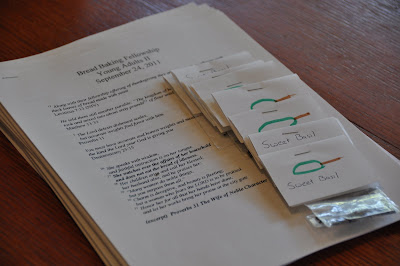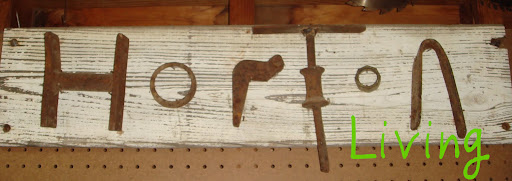On September 28th I taught a bread baking class for 10 women from my small group at church. It took a lot of planning, but I (and I think everyone else) had a wonderful time. I love to cook, I love to bake, and I love being able to share these things with people who are excited to learn.
A friend of one of the women was coming to town and she had heard that I liked to bake bread (is that really such an odd thing now? I guess so). It began as a few women getting together to bake bread at my house, after about a week, the guest list had grown and grown and I decided to make use of the commercial kitchen at our church.
The idea also expanded from just learning to bake a loaf of bread, to baking two kinds of bread, making pasta from scratch, and also cooking a full meal for everyone who participated. (Once again, for a Horton, it is not done until it is over done!).

We made French Bread and Craisin Walnut Celebration Bread. For dinner, we all helped to make fresh pasta with pesto cream sauce and grilled chicken.

In order to make it easier and more accessible for everyone, I had typed out a copy of all of the recipes, some applicable bible verses (amazing how many times 'bread' is mentioned in the bible) and a packet of our own Sweet Basil seeds for each of the women. One of the things I really wanted to accomplish in this class was to show them that baking from scratch was easy, it just takes time. Andrew helped to draw the basil leaf on each of the seed packets.
It was a little crazy at first, I've really only ever cooked for myself, my family, and small dinner parties, and I had never cooked in the kitchen at church before. As a practice run, I dragged my family and all my gear up to the church one quiet Sunday night and we let the kids watch a video while Curtis and I did a run through of the class. It went well, I was able to manage the huge kitchen and the big commercial ovens without much trouble.
The day of the class, we began at 4:30 in the afternoon with a target of eating dinner at 7:30. I began the class by starting up a batch of french bread as everyone watched. I explained the process of weighing, mixing and kneading, then turned everyone loose to begin their own loaves in pairs.
Everyone began gingerly, but eventually got the idea and started to have more fun with it.
We moved quickly through the recipes. One problem was that my bread baking makes use of scales to weigh the ingredients and I only had two good digital scales, and there were 4 pairs of people baking. This caused a bit of slow down at the beginning of each new recipe.
Before the class, I had printed out copies of all of the recipes for everyone, so they were able to move along at their own pace without too much input from me. I was able to hang back and only step in to help when someone had a question or I had a suggestion.

It was so much fun to not only explain how to bake the bread (anyone can follow a recipe, right?) but to also explain some of the 'why' behind what was happening in the recipe. For example, one helpful cue I came up with (as I watched my hubby manhandle his poor batch of dough during the practice session) was to describe 'kneading' as being like rolling out a play dough snake -- an analogy which went over very well with a group of young mommies! The purpose of kneading the dough is to help form the gluten into long strands in the dough. These long strands will be what catches the air as the yeast activates and help to make the bread light and yummy with lots of air pockets. As you knead dough correctly, it forms a sort-of skin over the surface, the point is to stretch this 'skin' without breaking it and you can do that by kneading it correctly.
I was able to watch and see four different batches of dough as they were being worked and I was able to show the class how each was progressing and the different aspects of making bread. I tried really hard to let each group do their own thing, but I did jump in a few times and help more than I probably should have. (I have been baking bread well for about 2 years now, and it is amazing how natural it feels to me. I only realized this as I watched how unnatural it seemed for someone who was learning it for the first time).
The class progressed quickly and I had to work to keep us on the schedule I had set out (so we could eat by a decent hour).
We made pasta with fresh eggs from our chickens at home. We made 6 batches of dough, 2 eggs each. (I wish I had thought to make 1 batch with store bought eggs so everyone could see the difference in 'yard bird' vs commercially kept chickens--the color difference is striking. The yard eggs make a dough that is a pretty yellow color, and the store egg dough is pale white).
Once all the breads were rising, I could tell that some of the class was starting to get restless, but a few were still very interested. I had planned on cooking much of the meal myself, but I was able to ask a few of the more focused women to take on a different part of the meal. One helper cooked the chicken (my least favorite part, and she did great!). One helper rolled out and cut the pasta dough, one helped me to make the pesto and one cooked the endless stream of noodles we made.
The last hour was a blur as it all came together.

Finally, success! The meal turned out great, the bread was delicious (and most of it was still baking as we sat down to eat. Part of my reason for doing the first loaf of french bread myself was to set the pace for the meal and to ensure that we had a loaf ready to eat by 7:30pm).
We were all able to sit, eat, relax and really enjoy each others company after a hard 3 hours of work in the kitchen.
I have organized a couple of 'girls nights' for a few of these women before. The nights were fun, we ate at a restaurant $$ and then met back at my house to visit. It is nice to visit, but I always felt like I had wasted a good kid-free evening at the end of the night. This class was so much better, we were able to visit, we were busy enough to really get to see each persons personality and we were able to accomplish a lot.
I think that much of the joy of cooking has really been lost in my generation. Between take-out food, 'brown and serve' dinners, and 30-minute meals we have had it beaten into our heads that cooking is an unpleasant chore and it should be tackled with as little effort as possible so we can get on to more important things. What can be more important than feeding your family or sharing a meal with friends? Yes, this meal took a solid 4 hours of work, but it was time spent with friends, and the dinner tasted so much better knowing that it was lovingly made. Admittedly, this was not a dinner I would tackle on a work night, but it made for a great Saturday evening with friends.
Even after all of the preparation and the work that went into the class, I went home energized and excited and already planning my next class.
Notes:
1) 10 people was the maximum that the church kitchen (and me) could handle at one time
2) stagger the start times or get more scales / sets of ingredients
3) needed baking stones to help the ovens maintain temperature while all that bread was being put it (the bread took too long to bake and never browned nicely due to the mass of bread being added at once)
4) This would be a great fund raiser for the church. Several people offered to pay (I said no) and the event was more fun that the bread class I paid $80 for in 2010
5) the church kitchen was missing most of the cooking implements (bowls, trays, pots, measuring spoons, stirring spoons) I'll need to plan for this better for next time. We need 1 bowl per recipe and that bowl cannot be re-used for the next recipe (bread has to rise in the bowl).




